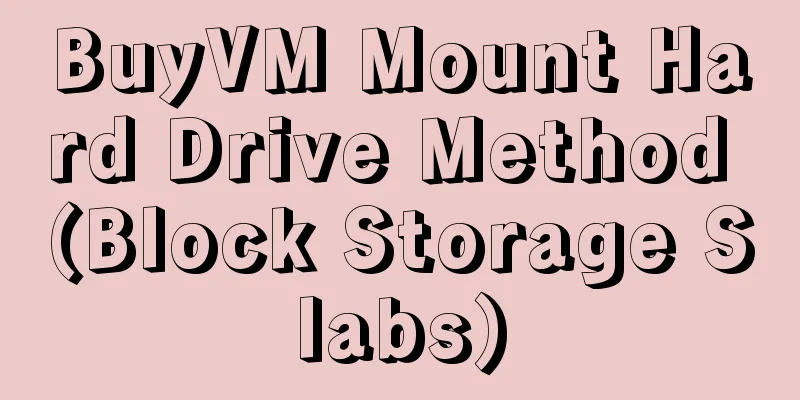BuyVM Mount Hard Drive Method (Block Storage Slabs)

|
This month we have shared information about BuyVM's products, reviews, and Stallion panel usage. We know that BuyVM also provides additional Block Storage Slabs products, and the price is quite cheap, 256GB storage is only $1.25/month. After purchasing Block Storage Slabs, you can mount it on your VPS host and turn it into a large disk machine in seconds. Today, let's take a look at how to mount a hard disk with BuyVM. BuyVM official website: https://buyvm.net/ 1. Panel OperationFirst, after we purchase Block Storage Slabs and activate it, we will receive a product information email. We can log in to the Stallion panel to view the storage information (click Storage Volumes at the panel header or click Volumes on the VPS management page). Then we assign the storage block to the VPS host (as shown below, click Attach To Virtual Server on the right) On the page that pops up below, we need to select our own VPS host in the Attach To box, and then click Attach Volume. After completing the allocation, our operations in the VPS management panel are completed. Next, we ssh into the VPS and start mounting it in the system. 2. System OperationLog in to the VPS host and use the command fdisk -l to see the disk space we allocated, as shown in the red box in the figure below. I bought a 256GB storage here. Next we will check the storage block name number, format the storage block, and mount the storage to the mount point. [root@ ~]# ls /dev/disk/by-id/ ata-QEMU_DVD-ROM_QM00004 scsi-0BUYVM_SLAB_VOLUME-10811 #View the storage block name number, etc. [root@ ~]# mkfs.ext4 -F /dev/disk/by-id/scsi-0BUYVM_SLAB_VOLUME-10811 #Format storage block [root@ ~]#mount -o discard,defaults /dev/disk/by-id/scsi-0BUYVM_SLAB_VOLUME-10811 /home #Mount the storage block to /home. If you need to mount it to other directories, please create the relevant directories first. After completion, we can use df -lh to check whether the partition is normal, and then add an automatic mount at startup. Edit /etc/fstab and add a line: /dev/disk/by-id/scsi-0BUYVM_SLAB_VOLUME-10811 /home ext4 defaults,nofail,discard 0 0 After that, you can restart to check whether it can be mounted normally. The overall operation is relatively convenient. Similarly, we can also uninstall and deallocate storage blocks, etc., and perform the reverse operation. |
<<: SpartanHost Seattle E5 series VPS restock, 10Gbps port, NVMe hard drive, 20% off monthly payment
>>: RAKsmart: 50% off all VPS hosting, VPS in Hong Kong/Japan/San Jose starting from $2.63 per month
Recommend
Clarity: Docker's four network modes
1. Closed container closed network mode It is equ...
Three-minute review! A quick overview of 5G industry development trends in September
Since the beginning of this year, with the introd...
5G network construction: NSA or SA first?
Different from the era from 3G to 4G, the evoluti...
Story: Tang Sanzang's journey to the west: the whole process of network communication
In the first year of Zhenguan, Xuanzang formed a ...
China's 5G is 10 times ahead, US companies abandon the "5G threshold" and turn to Korean companies to develop 6G
Recently, Google executives admitted that the Uni...
Why do base stations need to go to the sky?
Over the past few decades, mobile communication t...
Teach you how to choose the most suitable wireless AP
With the popularization of the Internet and the w...
Goodbye, 2G/3G is retiring
With the advent of the 5G era, there have been a ...
Inventory | 7 major acquisitions in the cybersecurity field recently
Cybersecurity is more important today than ever b...
RAKsmart: US servers start from $20/month for the first month, Japan/Korea servers start from $59/month, cluster servers start from $109/month
RAKsmart is carrying out the "New Year's...
Let’s talk about what is 5G CPE?
[[350048]] This article is reprinted from the WeC...
Goodbye, endless pop-up ads
In recent years, with the rapid development of mo...
Ministry of Industry and Information Technology: 4G users reached 1.296 billion, accounting for 80.9%
Recently, the Ministry of Industry and Informatio...
TCP reliable transmission, flow control, congestion control, the essence of TCP is all here
[[334785]] Table of contents Packet capture proce...









